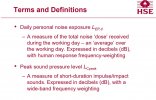I've done some reading around to try to guage what are safe volumes to listen to. The main source I'm gonna go off here is the UK Health & Safety Executive where they've investigated this area & come up with some guidance for employers, find the whole pdf file attached at end of post.
The crux of their measuring is based around a daily allowable Noise Dose which is expressed in percentage, with 100% being your maximum permitted Noise Dose for the day. They use the following two terms/variables to calculate/determine the Noise Dose: Lep and Lcpeak:
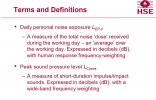
Lep is an average dB that you have been exposed to for that set time period, whereas Lcpeak is a peak single upper limit value (C-weighted) that is not to be crossed (so that's not an average).
They have two thresholds, an upper & lower limit set on these two previously mentioned variables whereby employers have to take certain actions to lower hearing damage risks. Here's the Lower Threshold:
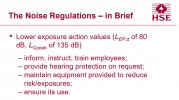
And here's the Upper Threshold and an important thing to note is that the Upper Threshold is equivalent to a 100% Noise Dose for your whole day (24hr period I believe):

They end up collating/boiling everything down that we've talked about here into one table that you can reference to determine your percentage daily Noise Dose that you've received from any given Lep (dB A-weighted), this seems highly useful and I think I'm going to endeavour to remain firmly in the green zone:

In the above table the previously mentioned Lower Threshold sits on the bottom edge of the Yellow Zone, whilst the previously mentioned Upper Threshold sits on the bottom edge of the red zone. You can see that a 100% Noise dose is associated with the Upper Threshold value that they previously mentioned which is a Lep of 85dB for an 8hr work day - you can read that off the above table.
So with this in mind, and me wanting to stay in the Green Zone then how do I interpret the sound level graphs that I captured from the tracks I listen to. Well here's a graph I created this morning based on A-weighted measurement which is the standard applied to the noise guidelines we've been talking about, following is a measurement of probably my loudest track I listen to recorded at my typical loud listening level:
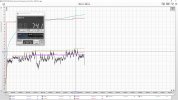
In the above graph the Lep is 80.5dB which is the lower purple line in that graph. If we look in the previous table we can see a Lep of 80dB over a 4hr period is still in the green zone, so according to that I'd be ok listening to that track at the volume level for 4hrs as it's below their Lower Threshold. However, they do cite an Lcpeak (C-weighted peak) as maximum level that would not be crossed at any point, so I did a C-weighted measurement of the same track, which is in the following graph:
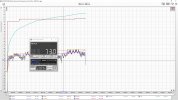
To be honest it looks like REW doesn't record Lcpeak, but it does record Lzpeak, with Lzpeak being Z-weighting rather than C-weighting - however we know that C-weighting is a bit more forgiving than Z-weighting because Z-weighting is literally just a flat line (no roll off in frequencies at any point), and as we can see from the following graph the C-Weighting rolls off in the bass:
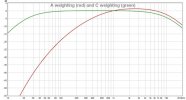
So given we know the Lzpeak in my recorded tracks are happening in the bass, and the C-weighting rolls off the bass then we can loosely interpret that we can shave off around 3dB from Lzpeak to roughly arrive at Lcpeak. So my Lzpeak was 102dB in that graph, so that's likely around 99dB for Lcpeak which is a long way below the 135dB Lcpeak of the Lower Threshold (yellow area on the table).
So in conclusion, I'd say firstly to make sure to keep your Lzpeak (below 135dB), and probably actually a fair bit lower because Lzpeak will be reached repetitively and often in music by the nature that it would be the bassline of the track so would happen every few seconds perhaps, whereas in the workplace you might expect your loudest noise events to be happening maybe say 3 times an hour, so I'd say be careful about Lzpeak.....most of my tracks I've measured don't go above 104dB Lzpeak, so that should be fine I'd say. Secondly I'd say use that table I posted earlier

and stay in the Green Zone. I'll probably aim for about half the threshold of the Green Zone, so 80dB Lep for 2hrs even though they have 4hrs as a maximum to stay in the green zone for that level......I suppose I have a bit of noise exposure at work and during the day, so I don't want to max out my daily dose with 4hrs of headphone listening at 80dB Lep whilst adding work exposure onto that too.....because afterall these are based on Daily Dose criteria. I also don't listen to headphones for 4hr in total anyway......although I sometimes could do that if gaming, so keep your headphones on low volume if you're doing long gaming sessions.
EDIT: just an additional piece of information, the same body that created these guidelines (HSE UK), also researched the long term effects of damage from noise exposure (or found it somewhere else, they don't cite a source), and that was actually their introduction to their presentation, here's the graph:
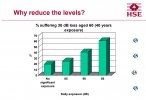
I'm assuming the units of the x-axis there is Lep for an 8hr period (even though they don't say). So I interpret that as an 85dB Lep for 8hr everyday gave a 5% increase in chance of someone suffering 30dB hearing loss at age 60.....although that says nothing for other lesser amounts of hearing loss or for hearing loss potential at younger ages. 85dB Lep for 8hrs is a 100% Daily Noise Dose, as seen in that colourful red/yellow/green table - just sitting in the lower edge of the red zone.
EDIT #2: I wonder if there is any other hearing damage noise exposure research out there that has been done that is contrary (contradicts) the information I've shown here, sometimes it's good to get other perspectives, anyone else found different research/guidelines that contradict the info here?
 It can be easy to get carried away with music you like but if other program material sounds too-loud it's probably too-loud.
It can be easy to get carried away with music you like but if other program material sounds too-loud it's probably too-loud.









